Looking for something else, I ran across the most recent coal consumption stats from the US Energy Information Administration. And from all indications it’s been a very strange, very bad year for the Transalta coal-fired power plant in Centralia, WA. Take a look:
The bars represent consumption of coal in Washington power plants for the first 5 months of each year—and since Centralia is the only dedicated coal-fired power plant in the state, the trend line is essentially identical to Centralia’s coal consumption. So as the pink bar shows, Centralia’s coal use for the first 5 months of this year was much, much lower than in any comparable period since 2002 (the earliest year for which I could easily find data).
And looking at the longer-term annual trends, it looks like the start of this year may well have been Centralia’s slowest since the plant was opened, way back in 1972.
If you care about climate trends, this is good news! Sure, the Transalta coal-fired power plant is already slated to be shuttered by 2025. Yet it remains a top source of climate pollution in the state, as well as a significant source of smog and mercury contamination.
But the chart does raise an interesting question: why is Centralia’s coal-fired power plant having such a terrible year?
I’m certainly no expert. But by every indication, 2011 has been a wacky year for the Northwest power markets. OPB’s Cassandra Profita has described it as “a perfect storm“: a snowy winter and wet spring has kept hydropower generation high; economic doldrums and mild west-coast weather have curbed demand for power; and new wind farms are competing with fossil fuels. In short, there’s a lot of power out there, but not a whole lot of demand.
Couple that with coal price trends: it’s getting more expensive for Centralia to buy coal, in part because of the massive price increases for coal exported from the US. At the same time, natural gas is cheaper than it’s been in years.
And what that says is simple: for the time being, the Centralia coal-fired power plant just isn’t making money. There’s not much demand for power, and when there is demand Centralia’s coal generators are often getting beaten out on price by natural gas. Obviously, these trends can turn on a dime. But for the time being at least, basic power economics are creating bad news for Transalta’s Centralia plant…and a bit of a bright spot for the state’s emissions trends this year.


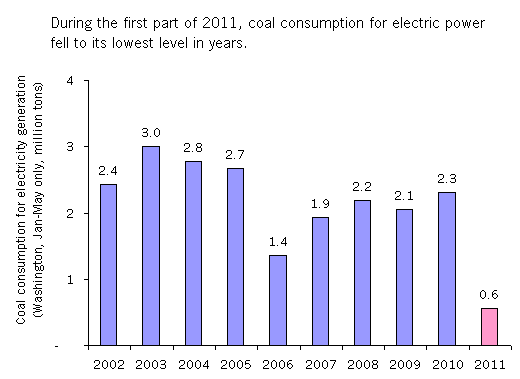
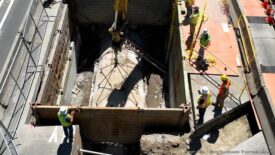
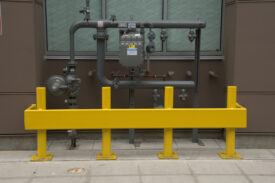
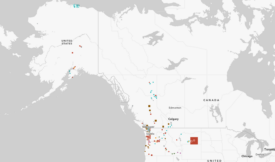
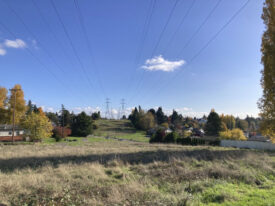
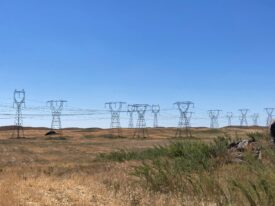

Larry
The only reason the coal consumption was down was because they were down for maintenance for the last few months.
Clark Williams-Derry
That’s an excellent point! Do you happen to know if they started the maintenance prior to May, though? The consumption numbers in the chart above only run from January through May.
If Centralia was closed for maintenance for much of Jan-May, I’ll be sure to update the post!
Clark Williams-Derry
Googling a bit, it looks like the weak market offered an opportunity to do some maintenance — i.e., they decided to “economically dispatch” Transalta (read — mostly shut down) based on weak market conditions.
From a Transalta press release:
“During the quarter, the decision was made to economically dispatch the Centralia Thermal facility to take advantage of the weak market conditions in the region. Contracted supply obligations were met through open market purchases while maintaining gross margins objectives. The outages also provided additional opportunities to efficiently perform maintenance work…”
What this means, of course, is that it was cheaper for Transalta to fulfill its contracts by buying wholesale power from the (glutted) power markets than by running its coal plant at Centralia. It’s been a good year for Transalta, financially, and a good opportunity for maintenance. But it’s definitely been a slow time for the facility as a power generator.
Karen
FYI – “Economically Dispatch” just means roughly “decide how much power to produce based on how much system wide supply/demand there is and how much it costs to produce energy at this plant.” The thing that implies “mostly shuttering” is the weak economic conditions. “Economic Dispatch” is a term that actually implies nothing about Transalta’s fortunes. (You’d be just as likely to see the term in an article about record high coal consumption.)
Clark Williams-Derry
Karen-
Agreed. My read of “economically dispatch…to take advantage of weak market conditions” was that it was a euphemism/corporate PR-speak for “we’re going to turn off the dang boilers and buy cheap power on the wholesale market.” Arguably, merchant power plants like Transalta’s Centralia plant ALWAYS economically dispatch their generators.